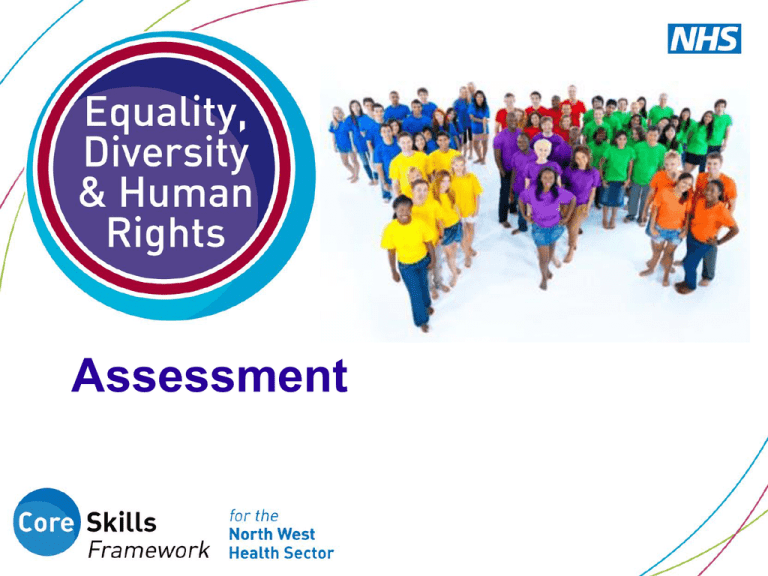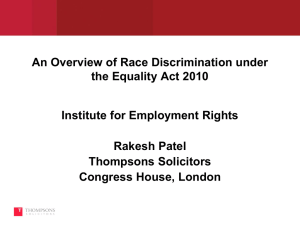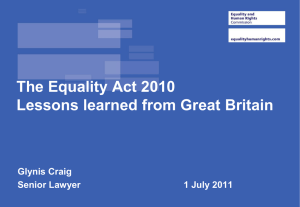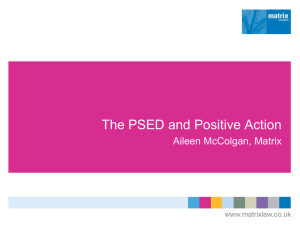
Assessment
1. What does equality mean?
100%
1.
2.
Treating everyone in the
same way
Treating people
differently but fairly with
an equal level of respect
0%
1
2
Correct Answer - 2 Treating people
differently but fairly with an equal
level of respect
Equality is about making sure people are
treated fairly. Equality is not about treating
everyone in the same way, but it recognises
that their individual needs are met in
different ways
Equality is about creating a fairer society
where everyone has the opportunity to fulfil
their potential
2. What does diversity mean?
100%
1.
2.
Valuing and embracing
differences in people
Treating people
differently because of
their ethnicity
0%
1
2
Correct answer - 1 Valuing and
embracing differences in people
Diversity is about recognising and valuing individual as
well as group differences in the community/ workplace
and within the workforce.
Diversity is about recognising and valuing difference in
its broadest sense.
Diversity is where many different types of people are
included
3. According to the Equality Act 2010
which of the following is not a protected
characteristic?
100%
1.
2.
3.
4.
5.
6.
Gender Reassignment
Political Party
Membership
Marriage and Civil
Partnership
Pregnancy and Maternity
Sexual Orientation
Religion and Belief
0%
0%
1
2
3
0%
0%
0%
0%
4
5
6
7
Correct answer - 2 Political Party Membership
Protected characteristics
Under the Equality Act 2010 the Protected
Characteristics are the grounds upon which
discrimination is unlawful. The characteristics
are: age, disability, gender reassignment,
marriage and civil partnership, pregnancy and
maternity, race, religion or belief, sex and
sexual orientation.
4. Indirect discrimination is generally
acceptable behaviour
100%
1.
2.
True
False
0%
1
2
Correct answer – 2 False
Direct discrimination
Less favourable treatment of a person compared with another person
because of a protected characteristic.
The characteristics are: age, disability, gender reassignment, marriage and
civil partnership, pregnancy and maternity, race, religion or belief, sex and
sexual orientation.
Indirect discrimination
The use of an apparently neutral practice, provision or criterion which puts
people with a particular protected characteristic at a disadvantage
compared with others who do not share that characteristic, and applying
the practice, provision or criterion cannot be objectively justified.
5. Where are your human rights set out?
1.
2.
3.
4.
100%
Age Discrimination
Legislation 2006
Equality Act 2010
Human Rights Act 1998
Disability Discrimination
Act 1995
0%
1
0%
2
0%
3
4
Correct answer – 3 Human Rights Act 1998
The Human Rights Act 1998 sets out the rights in the UK which
are protected by the European Convention on Human Rights.
The Act gives greater effect within the UK to the rights and
freedoms protected by the European Convention on Human
Rights, an international treaty to protect human rights and
fundamental freedoms in Europe which British lawyers helped to
draft.
The Human Rights Act means that these basic rights and
freedoms within the treaty are now more easily protected in the
UK
6. 'Human rights' are the basic rights and
freedoms that belong to every person in the
United Kingdom.
100%
1.
2.
True
False
0%
1
2
Correct answer – 1 True
Human rights and freedoms are based on core
principles like dignity, fairness, equality
respect and autonomy
The Human Rights Act 1998 made these
human rights part of our domestic law
7. Not all rights under the Human Rights
Act 1998 are absolute
1.
2.
True
False
93%
7%
1
2
Correct answer – 1 True
The Human Rights Act 1998 introduces a notion of variance.
Absolute rights cannot be infringed under any circumstances. These are the
Right to Life, Prohibition of torture and degrading treatment, Prohibition of
Slavery and Forced Labour and No Punishment Without Law.
Qualified rights are rights that the state can lawfully interfere with in certain
circumstances. Interference with these must be lawful, legitimate, necessary
and proportionate.
An example of a qualified right is freedom of expression, which is acceptable to
curtail if expression leads to incitement to hatred.
Right to liberty and security is an example of a limited right. This means that it
will be unlawful to deprive and individual of liberty unless there are valid (legal)
grounds to do so. Sectioning under the Mental Health Act to prevent harm to
self or others is an example of this.
8. A job advert that asks for someone of
a particular gender, colour, race, nationality,
sexual orientation or who speaks a certain
language is:
100%
1.
2.
3.
Illegal
Legal
Only legal if there is
reasonable justification
0%
1
0%
2
3
Correct answer - 3 only legal if
there is reasonable justification
An employer does not have to advertise a job vacancy in a particular way or at all.
But if they don’t advertise at all or they advertise in a way that won’t reach people with a particular protected
characteristic, this might in some situations lead to indirect discrimination, unless they can objectively justify this
approach.
For example
It is possible to restrict a job to members of one sex if being of that sex is a genuine occupational qualification for the
job but the circumstances where this may apply are very limited. They might include:
Where the essential nature of the job calls for a person of that sex for reasons of physiology (excluding physical
strength or stamina
Where the job needs to be held by a person of that sex to preserve decency or privacy because of likely physical
contact or because people are likely to be in a state of undress or using sanitary facilities.
Where the work is done at a single sex hospital, prison or other establishment for persons requiring special care,
supervision or attention and it is reasonable, having regard to the essential character of the establishment, that the job
should not be held by a person of the opposite sex.
It is possible to restrict a job to members of a particular racial group. This might include:
When being from a particular racial group is a 'genuine occupational qualification' for a job.
When an organisation is taking positive action to encourage people from a certain racial group to apply for a job or
training because they are underrepresented in the organisation or at certain job levels.
9. When deciding whether an adjustment
is reasonable for someone with a disability
what should an organisation consider:
100%
1.
2.
3.
How effective the change
will be in assisting disabled
people in general or a
particular customer, client,
service user or member
Whether it can actually be
done
If the cost is manageable
0%
1
2
0%
3
Correct answer - 1 How effective the change
will be in assisting disabled people in
general or a particular customer, client,
service user or member
Duty to make reasonable adjustments
Where a disabled person is at a substantial disadvantage
in comparison with people who are not disabled, there is a
duty to take reasonable steps to remove that
disadvantage by (i) changing provisions, criteria or
practices, (ii) altering, removing or providing a reasonable
alternative means of avoiding physical features and (iii)
providing auxiliary aids
10. The general equality duty is set out in the
Equality Act 2010. Which of the following does
it not aim to do?
1.
2.
3.
4.
Eliminate unlawful
discrimination, harassment
and victimisation
Report discriminatory
behaviour to the press
Advance equality of
opportunity between
different groups
Foster good relations
between different groups
100%
0%
1
0%
2
3
0%
4
Correct answer is – 2 Report
discriminatory behaviour to the press
General equality duty
The public sector equality duty consists of a general equality duty, which is
set out in section 149 of the Equality Act 2010 itself, and specific duties
which are imposed by secondary legislation. The general equality duty
came into force on 5 April 2011.
In summary, those subject to the equality duty must, in the exercise of their
functions, have due regard to the need to:
Eliminate unlawful discrimination, harassment and victimisation and other
conduct prohibited by the Act.
Advance equality of opportunity between people who share a protected
characteristic and those who do not.
Foster good relations between people who share a protected characteristic
and those who do not.
THANK YOU
End of the assessment
Delegate Scores
10
Rachael BYRNE
10
Samantha Elise KEANE
10
Kirsty Anne FORREST
10
Emily Jane GARNETT
10
Hannah Claire STOKES
10
Vicki-lea BELL
10
Anne-Marie BOOTH
9
Emma SADLER
10
Rachel ASTLES
10
Amy GREGORY
10
Ashley-marie SMITH
10
Stacey Barbara HEATH
10
Thomas Luke KELLETT
10
Rachael Victoria JONES












